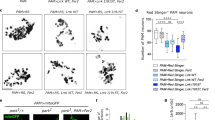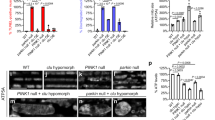Abstract
Mitochondrial dysfunction has emerged as a common theme that underlies numerous neurological disorders, including Down syndrome. Down syndrome cultures and tissues show mitochondrial damage such as impaired mitochondrial enzyme activities, defective mitochondrial DNA repairs and accumulation of toxic free radicals, but the cause of mitochondrial dysfunction remains elusive. Here we demonstrate that the Drosophila melanogaster homolog of human Down syndrome critical region gene 1 (DSCR1), nebula (also known as sarah, sra), has a crucial role in the maintenance of mitochondrial function and integrity. We report that nebula protein is located in the mitochondria. An alteration in the abundance of nebula affects mitochondrial enzyme activities, mitochondrial DNA content, and the number and size of mitochondria. Furthermore, nebula interacts with the ADP/ATP translocator and influences its activity. These results identify nebula/DSCR1 as a regulator of mitochondrial function and integrity and further suggest that an increased level of DSCR1 may contribute to the mitochondrial dysfunction seen in Down syndrome.
This is a preview of subscription content, access via your institution
Access options
Subscribe to this journal
Receive 12 print issues and online access
$209.00 per year
only $17.42 per issue
Buy this article
- Purchase on Springer Link
- Instant access to full article PDF
Prices may be subject to local taxes which are calculated during checkout







Similar content being viewed by others
References
Mattson, M.P. & Liu, D. Energetics and oxidative stress in synaptic plasticity and neurodegenerative disorders. Neuromolecular Med. 2, 215–231 (2002).
Balaban, R.S., Nemoto, S. & Finkel, T. Mitochondria, oxidants, and aging. Cell 120, 483–495 (2005).
Wallace, D.C. Mitochondrial diseases in man and mouse. Science 283, 1482–1488 (1999).
Arbuzova, S., Hutchin, T. & Cuckle, H. Mitochondrial dysfunction and Down's syndrome. Bioessays 24, 681–684 (2002).
Busciglio, J. & Yankner, B.A. Apoptosis and increased generation of reactive oxygen species in Down's syndrome neurons in vitro. Nature 378, 776–779 (1995).
Busciglio, J. et al. Altered metabolism of the amyloid beta precursor protein is associated with mitochondrial dysfunction in Down's syndrome. Neuron 33, 677–688 (2002).
Zeviani, M. & Carelli, V. Mitochondrial disorders. Curr. Opin. Neurol. 16, 585–594 (2003).
Prince, J., Jia, S., Bave, U., Anneren, G. & Oreland, L. Mitochondrial enzyme deficiencies in Down's syndrome. J. Neural Transm. Park. Dis. Dement. Sect. 8, 171–181 (1994).
Druzhyna, N., Nair, R.G., LeDoux, S.P. & Wilson, G.L. Defective repair of oxidative damage in mitochondrial DNA in Down's syndrome. Mutat. Res. 409, 81–89 (1998).
Capone, G. et al. Evidence for increased mitochondrial superoxide production in Down syndrome. Life Sci. 70, 2885–2895 (2002).
Fuentes, J.J. et al. A new human gene from the Down syndrome critical region encodes a proline-rich protein highly expressed in fetal brain and heart. Hum. Mol. Genet. 4, 1935–1944 (1995).
Chang, K.T., Shi, Y.J. & Min, K.T. The Drosophila homolog of Down's syndrome critical region 1 gene regulates learning: implications for mental retardation. Proc. Natl. Acad. Sci. USA 100, 15794–15799 (2003).
Fuentes, J.J. et al. DSCR1, overexpressed in Down syndrome, is an inhibitor of calcineurin-mediated signaling pathways. Hum. Mol. Genet. 9, 1681–1690 (2000).
Kingsbury, T.J. & Cunningham, K.W. A conserved family of calcineurin regulators. Genes Dev. 14, 1595–1604 (2000).
Rothermel, B. et al. A protein encoded within the Down syndrome critical region is enriched in striated muscles and inhibits calcineurin signaling. J. Biol. Chem. 275, 8719–8725 (2000).
Ryeom, S., Greenwald, R.J., Sharpe, A.H. & McKeon, F. The threshold pattern of calcineurin-dependent gene expression is altered by loss of the endogenous inhibitor calcipressin. Nat. Immunol. 4, 874–881 (2003).
Ermak, G., Harris, C.D. & Davies, K.J. The DSCR1 (Adapt78) isoform 1 protein calcipressin 1 inhibits calcineurin and protects against acute calcium-mediated stress damage, including transient oxidative stress. FASEB J. 16, 814–824 (2002).
Crawford, D.R. et al. Hamster adapt78 mRNA is a Down syndrome critical region homologue that is inducible by oxidative stress. Arch. Biochem. Biophys. 342, 6–12 (1997).
Leahy, K.P. & Crawford, D.R. adapt78 protects cells against stress damage and suppresses cell growth. Arch. Biochem. Biophys. 379, 221–228 (2000).
Lewis, D.L., Farr, C.L. & Kaguni, L.S. Drosophila melanogaster mitochondrial DNA: completion of the nucleotide sequence and evolutionary comparisons. Insect Mol. Biol. 4, 263–278 (1995).
Pfister, S.C., Machado-Santelli, G.M., Han, S.W. & Henrique-Silva, F. Mutational analyses of the signals involved in the subcellular location of DSCR1. BMC Cell Biol. 3, 24 (2002).
Genesca, L. et al. Phosphorylation of calcipressin 1 increases its ability to inhibit calcineurin and decreases calcipressin half-life. Biochem. J. 374, 567–575 (2003).
Lin, H.Y. et al. Oxidative and calcium stress regulate DSCR1 (Adapt78/MCIP1) protein. Free Radic. Biol. Med. 35, 528–539 (2003).
Hilioti, Z. et al. GSK-3 kinases enhance calcineurin signaling by phosphorylation of RCNs. Genes Dev. 18, 35–47 (2004).
Vega, R.B., Yang, J., Rothermel, B.A., Bassel-Duby, R. & Williams, R.S. Multiple domains of MCIP1 contribute to inhibition of calcineurin activity. J. Biol. Chem. 277, 30401–30407 (2002).
Zhang, Y.Q. et al. stress sensitive B encodes an adenine nucleotide translocase in Drosophila melanogaster. Genetics 153, 891–903 (1999).
Klingenber, M. in The Enzymes of Biological Membranes (ed. Martonosi, A.N.) (Plenum, New York, 1985).
Homyk, T., Jr . Behavioral mutations of Drosophila melanogaster. II. Behavioral analysis and locus mapping. Genetics 87, 105–128 (1977).
Royden, C.S., Pirrotta, V. & Jan, L.Y. The tko locus, site of a behavioral mutation in D. melanogaster, codes for a protein homologous to prokaryotic ribosomal protein S12. Cell 51, 165–173 (1987).
Sullivan, K.M. & Rubin, G.M. The Ca(2+)-calmodulin-activated protein phosphatase calcineurin negatively regulates EGF receptor signaling in Drosophila development. Genetics 161, 183–193 (2002).
Gajewski, K. et al. Requirement of the calcineurin subunit gene canB2 for indirect flight muscle formation in Drosophila. Proc. Natl. Acad. Sci. USA 100, 1040–1045 (2003).
Graham, B.H. et al. A mouse model for mitochondrial myopathy and cardiomyopathy resulting from a deficiency in the heart/muscle isoform of the adenine nucleotide translocator. Nat. Genet. 16, 226–234 (1997).
Esposito, L.A., Melov, S., Panov, A., Cottrell, B.A. & Wallace, D.C. Mitochondrial disease in mouse results in increased oxidative stress. Proc. Natl. Acad. Sci. USA 96, 4820–4825 (1999).
Kaukonen, J. et al. Role of adenine nucleotide translocator 1 in mtDNA maintenance. Science 289, 782–785 (2000).
Biousse, V., Pardue, M.T., Wallace, D.C. & Newman, N.J. The eyes of mito-mouse: mouse models of mitochondrial disease. J. Neuroophthalmol. 22, 279–285 (2002).
Wallace, D.C. Mouse models for mitochondrial disease. Am. J. Med. Genet. 106, 71–93 (2001).
St-Pierre, J., Buckingham, J.A., Roebuck, S.J. & Brand, M.D. Topology of superoxide production from different sites in the mitochondrial electron transport chain. J. Biol. Chem. 277, 44784–44790 (2002).
Strippoli, P., Lenzi, L., Petrini, M., Carinci, P. & Zannotti, M. A new gene family including DSCR1 (Down Syndrome Candidate Region 1) and ZAKI-4: characterization from yeast to human and identification of DSCR1-like 2, a novel human member (DSCR1L2). Genomics 64, 252–263 (2000).
Hodson, D., Gatward, G. & Erber, W. Azurophilic granules in acute lymphoblastic leukaemia resulting from abundant mitochondria. Br. J. Haematol. 125, 265 (2004).
Hirai, K. et al. Mitochondrial abnormalities in Alzheimer's disease. J. Neurosci. 21, 3017–3023 (2001).
Wong-Riley, M. et al. Cytochrome oxidase in Alzheimer's disease: biochemical, histochemical, and immunohistochemical analyses of the visual and other systems. Vision Res. 37, 3593–3608 (1997).
Roizen, N.J. & Patterson, D. Down's syndrome. Lancet 361, 1281–1289 (2003).
Menendez, M. Down syndrome, Alzheimer's disease and seizures. Brain Dev. 27, 246–252 (2005).
Ermak, G., Morgan, T.E. & Davies, K.J. Chronic overexpression of the calcineurin inhibitory gene DSCR1 (Adapt78) is associated with Alzheimer's disease. J. Biol. Chem. 276, 38787–38794 (2001).
Gardiner, K. et al. Report on the 'Expert workshop on the biology of chromosome 21: towards gene-phenotype correlations in Down syndrome', held June 11–14, 2004, Washington D.C. Cytogenet. Genome Res. 108, 269–77 (2005).
Cvejic, S., Zhu, Z., Felice, S.J., Berman, Y. & Huang, X.Y. The endogenous ligand Stunted of the GPCR Methuselah extends lifespan in Drosophila. Nat. Cell Biol. 6, 540–546 (2004).
Tokuyasu, K.T. Immunochemistry on ultrathin frozen sections. Histochem. J. 12, 381–403 (1980).
Wu, C.F., Suzuki, N. & Poo, M.M. Dissociated neurons from normal and mutant Drosophila larval central nervous system in cell culture. J. Neurosci. 3, 1888–1899 (1983).
Duan, J. & Karmazyn, M. Relationship between oxidative phosphorylation and adenine nucleotide translocase activity of two populations of cardiac mitochondria and mechanical recovery of ischemic hearts following reperfusion. Can. J. Physiol. Pharmacol. 67, 704–709 (1989).
Ganetzky, B. & Wu, C.F. Drosophila mutants with opposing effects on nerve excitability: genetic and spatial interactions in repetitive firing. J. Neurophysiol. 47, 501–514 (1982).
Acknowledgements
We thank the EM Facility, Protein/Peptide Sequencing Facility and Light Imaging Facility at NINDS, NIH for assistance; EM Facility at Johns Hopkins University for help with immunogold electron microscopy; M. Ashburner for the sesB1 stock; R. Garesse for the ATPβ synthase antibody; the Brain and Tissue Bank at the University of Maryland, Baltimore, for fetal brain tissues; H. Nash and K. Fischbeck for critical reading of the manuscript; and Y. Shi for technical assistance. This work was supported by an intramural fund from NINDS, NIH, and funds from the March of Dimes Birth Defects Foundation to K.-T.M.
Author information
Authors and Affiliations
Corresponding author
Ethics declarations
Competing interests
The authors declare no competing financial interests.
Supplementary information
Supplementary Fig. 1
Specificity of the nebula antibody. (PDF 403 kb)
Supplementary Fig. 2
nebula mutants show a profound increase in the number of mitochondria. (PDF 778 kb)
Supplementary Fig. 3
Nebula is mainly found in the soluble mitochondrial fraction. (PDF 107 kb)
Supplementary Fig. 4
Summary of nebula function. (PDF 62 kb)
Rights and permissions
About this article
Cite this article
Chang, K., Min, KT. Drosophila melanogaster homolog of Down syndrome critical region 1 is critical for mitochondrial function. Nat Neurosci 8, 1577–1585 (2005). https://doi.org/10.1038/nn1564
Received:
Accepted:
Published:
Issue Date:
DOI: https://doi.org/10.1038/nn1564
This article is cited by
-
Neuroprotective Effects of Lycium Barbarum Fruit Extract on Pink1B9Drosophila Melanogaster Genetic Model of Parkinson’s Disease
Plant Foods for Human Nutrition (2023)
-
Mitochondrial dysfunction in down syndrome: molecular mechanisms and therapeutic targets
Molecular Medicine (2018)
-
Spermine synthase deficiency causes lysosomal dysfunction and oxidative stress in models of Snyder-Robinson syndrome
Nature Communications (2017)
-
Effects of sarah/nebula knockdown on Aβ42-induced phenotypes during Drosophila development
Genes & Genomics (2016)
-
RCAN1 overexpression promotes age-dependent mitochondrial dysregulation related to neurodegeneration in Alzheimer’s disease
Acta Neuropathologica (2015)



